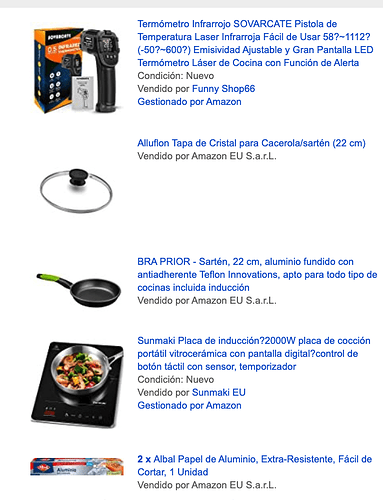I realize I really don’t know how the physical world actually behaves in terms of how heat works!
Particularly re Point 11 in Richard’s article: “In the physical world no externally heated substance can raise the temperature of its heat-source.”
Even though the result of this experiment won’t affect the validity of the article as a whole (as the other 11 points would still remain, namely the Earth is not flat, not black, not irradiated by 1/4th the rays, etc…), I like to be thorough and I also want to actually know how the world behaves.
So I devised a little experiment to actually see what happens… it involves the following equipment which will arrive Tuesday (total cost under 150 EUR):
It consists of the following setup:
- Induction Skillet: a 22cm (16.3cm base) skillet that works on an induction plate
- Induction Plate: This can be set to generate a constant 200W of power into the skillet
- Glass Cover: to fit snugly over the skillet
- Aluminum Foil: which is said to reflect ~95% infrared light[1]
The experiment consists of 4 steps:
- Baseline: let everything sit out and get to room temperature. Measure the temperature of everything with the IR thermometer, should all be the same (e.g. ~20°C).
- Open: Put the skillet on the induction plate, uncovered. Turn it on to 200W. Let it sit until temperature equilibrium is reached. Measure the temperature of the skillet (the top of the base, the inside side, and the outside side, to get a good idea of how the heat distributing)
- Covered: Start as with “Open”. Once equilibrium reached, place the bare glass cover on it (no foil). Let everything reach equilbrium again. Measure temperature of the glass top and bottom, and the skillet.
- Foiled: Layer the bottom of the glass cover with aluminum foil. Repeat same steps as in “Covered”.
- Gassed: covered or foiled but adding CO2 gas in it with vinegar and baking soda!
The question is: how will the temperature of the base of the skillet compare between 2, 3, and 4?
With some rough math using the Stefan-Boltzmann Law and assuming room temperature of 20°C, and that the skillet is 5cm tall, and that it emits radiation across one side of the base and both sides of the sides (inside and outside), I figure that on the “Open” setup it should reach ~151°C. This can be wildly off, but we shall see.
Then…
Hypothesis 1: If you follow the same reasoning as with the “greenhouse gases” warming up the planet above what it otherwise would be, then when you cover it, the glass lid will heat up. Now the glass lid will itself emit infrared radiation back down to the skillet. Now the skillet is receiving more radiation than it otherwise would be. Rough calculation is it should get to ~192°C instead, with the glass being around the same temperature (somehow I got ~207°C for the glass, which seems wrong, but it’s enough to get a rough idea).
Then when you cover the bottom of the glass with foil, now it should be reflecting 95% of the radiation back, instead of just absorbing and basically emitting 50%, so the skillet should get much, much hotter. It should get to at least 255°C and maybe a lot more – I didn’t fully do all the math but it’s enough to get an idea. Meanwhile the glass itself should stay at the same temperature as without being covered since it’s absorbing less of it.
Hypothesis 2: Following the immediate common sense logic of how the world behaves, the glass cover, since it’s being heated by the skillet, won’t end up heating the skillet more than it started at. The glass will get to at most the same temperature as in the “Open” scenario (~151°C), while the skillet temp will be unchanged. The addition of the foil likewise won’t change anything (except maybe the glass will not get as hot since it absorbing less).
Hypothesis 3: “Covered” will lose less heat to convection so surface will be a bit hotter than otherwise. “Foiled” won’t increase temp much or at all since that effect already will be saturated by then.
Possible Problems/Issues/Thoughts:
-
I will have to take the glass lid off to measure the skillet temp. But if the skillet does really get hotter it should remain at the higher temp long enough to get a good reading (~0.5s according to the IR thermometer specs).
-
The predicted temp ranges might be wildly off with the math, but I calculate it should be different enough (at least ~50°C between each setup) that a difference should be noticeable. And they are all within the IR thermometer’s range (-50°C to 600°C)
-
The actual heat source isn’t the skillet base per se, but the coils inside the skillet, that the induction plate passes a current through to heat up. It is possible these coils themselves are hotter than the skillet gets to in the initial “Open” set up. In fact according to the Stefan-Boltzmann equation math, if their surface area is smaller then they have to be (lower surface area means higher W/m^2 and thus higher temperature). But as they are coils vs a solid surface their surface area may be greater…
In any case in this case the skillet base will get hotter when “Covered” and “Foiled”, and this could invalidate the experiment as I’m not sure if I could measure the temp of the coils themselves vs. the skillet. Any thoughts??
Curious to see the result. What do you guys think will happen? Anyone see issues with the experimental setup?
